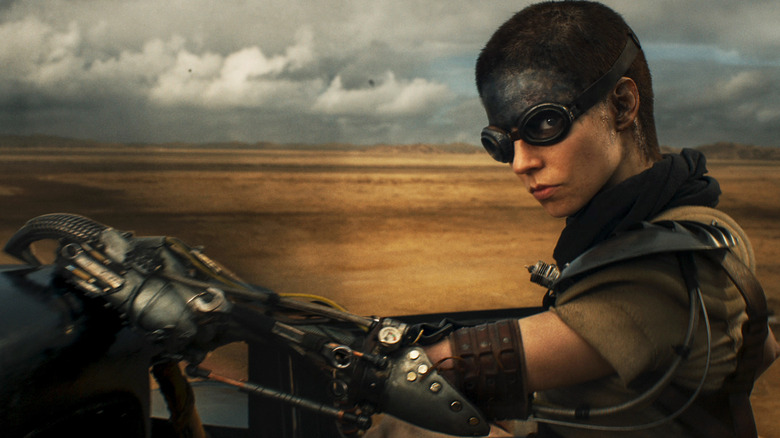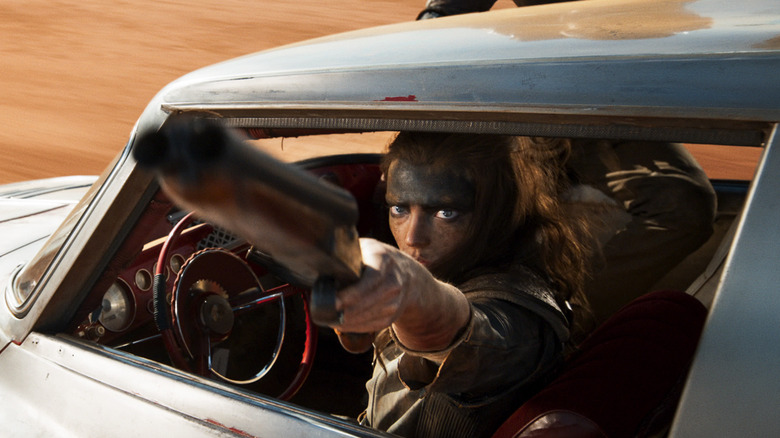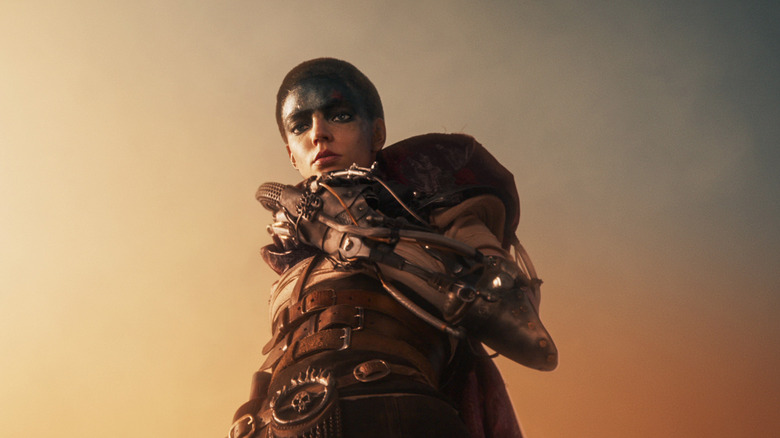Furiosa Returns The Mad Max Series To Its Gnarly, Revenge-Driven Roots
This article contains spoilers for "Furiosa."
Even though there are currently only five films within the "Mad Max" saga, the movies span an impressive number of decades, from the late 1970s to 2024. Naturally, there has been quite an evolution within cinema during that time, both for the medium itself as well as for the saga's director, George Miller. At age 79, Miller shows no interest in settling into any rigid stylistic groove.
As times have changed, so has the look and feel of the "Mad Max" films, and one could make the case that each successive installment of the series has expanded in ambition and scope concurrent with most long-running film franchises. With the second film, "Mad Max 2," and the fourth, "Fury Road," being (as of now) the most popular and influential installments of the saga, there's never been any real call to do what so many less successful franchises tend to do, which is return to the series' roots. After all, when faced with the expansive, dynamic, visually stuffed frames of "Fury Road," the original "Mad Max" seems humble by comparison, a scrappy Aussie indie that has given way to bigger and better things.
However, one of the joys of the latest installment in the series, "Furiosa," is that it continues the franchise's penchant for exploring new corners of the Wasteland by taking what is perhaps the most totally unexpected turn: telling a story that's as revenge-fueled, gnarly, and (most importantly) single-character centric as the original "Mad Max."
'Furiosa' is far more 'Mad Max' than 'Fury Road'
While the majority of critical responses to "Furiosa" are generally very positive, there are a number of dissenting opinions, many of which are making unfavorable comparisons between this film and "Fury Road." Even though "Furiosa" was bound to be compared to the prior entry, given that it is a prequel to it — a quality that Miller doesn't once shy away from, and even explicitly encourages — it still feels a little disingenuous to be too harsh with that comparison. Especially as the entire structure, pace, and even tone of "Furiosa" is hardly attempting to compete.
To be fair, most of the "Mad Max" films concern an ensemble of characters looking to reach disparate goals within a constrained space and time, with each film taking place over the course of a few days. In contrast to this are the stories of "Mad Max" and "Furiosa": both take place over an extended period (for "Max," weeks or months; for "Furiosa," years), both have a tighter focus on their titular protagonists and their singular goals than those of the supporting characters surrounding them, and both chronicle the steady deterioration of the social structures they exist within.
Perhaps the most obvious way "Furiosa" and "Mad Max" resemble each other lies in the fact that both films follow their heroes' quest to escape their respective situations until personal loss and tragedy sets them on a quest for vengeance. It's no mistake that a series as mythic as "Mad Max," with all its echoes and resonances, sees Furiosa (Anya Taylor-Joy) hunting down the leader of a vicious biker gang who murdered her loved ones, Dementus (Chris Hemsworth), just as Max (Mel Gibson) hunted down ... the leader of a vicious biker gang, Toecutter (Hugh Keays-Byrne), who murdered his loved ones.
How 'Furiosa' continues to elevate Furiosa's character
The central arc for Max (Tom Hardy) in "Fury Road" involves his coming to support Furiosa (Charlize Theron). Max, a character broken by all the lives he failed to save as well as all the misdeeds he's committed over time, comes to understand that Furiosa is a superior version of himself, someone who can help lead what remains of humanity to better days.
For all intents and purposes, Furiosa is the first major character in the "Mad Max" films to proudly stand on the same level as or even above Max; after all, they're the only two characters in the series to have films centered around them (and I don't think we're going to get "The Adventures of Scrotus" anytime soon). "Furiosa" goes even further than that with the comparison, however: the last act of the film (cheekily entitled "Beyond Vengeance") sees Dementus at the complete mercy of Furiosa, just as the final scene of "Mad Max" sees the last remaining (and somewhat reluctant) gang member, Johnny the Boy (Tim Burns), at Max's behest.
Where Max, during that encounter, essentially turns into Jigsaw, forcing Johnny to chain himself to a car that's due to explode any minute while giving him a chance to saw his own foot off and escape, Furiosa pointedly does not torture Dementus. At least, she doesn't torture him in the way he seems to want her to, as he deliberately goads and taunts her. What she does instead is torment him, and ultimately makes a useful, more progressive example out of him than just a rotting corpse left in the desert.
In essence, "Furiosa" demonstrates that Furiosa is the yin to Max's yang, a woman who deserves to be let up into the Citadel at the end of "Fury Road" while Max ventures away. There but for the grace of Max goes she.
"Furiosa" is in theaters now.


